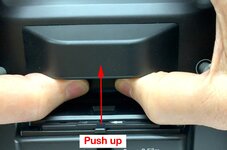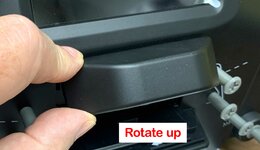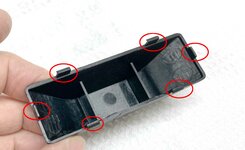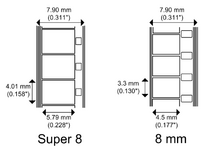Modding the Kodak Reels 8mm Film Digitizer (Firmware Hack)
- Thread starter Mac84
- Start date
You are using an out of date browser. It may not display this or other websites correctly.
You should upgrade or use an alternative browser.
You should upgrade or use an alternative browser.
White balance is now adjustable in the 6.6 version. Just go to the where you adjust sharpness and there is a white balance control now.Thanks for the answer, I have to use version C. And I have a problem with the white balance on this one. It goes a lot towards the blue shade.
If there is a relationship between compression and the jitter, it would only be compression size of the first few frames. As I've noticed that once the jitter starts is it always there, which which why I found setting the short shutter helpful (like it moves the jitter out of frame.) You can test the compression theory by starting the encoding on blank leader. The compression is adjustable. I set a start QP factory and a maximum QP. I think is starts around 24 and slowly increases to 18 or 19. If there is a buffer overflow warning, I drop the QP back to 24, it does this continuously for a crude rate control. I'm not trying for 35Mb/s, but rather the high quality while keep the capture reliable. For the high grain source these might both be too high. So rather than changing the sharpness, change the QP limits. There is some documentation in the binaries.New update.
The Tri X film is a nasty one with a lot of visible grain and the development in Caffenol accentuate it.
My attention was captured by the high bitrate that the previous clip had eq. 46.7 Mbit/s, well above the 35 Mbit/s 0dan0 set.
View attachment 22945
So i tried to to reduce sharpness more, at -1.5 and -2. At -2 I hit the sweet spot of 34.6, loosing in definition but removing the jitter effect quite completely.
The clip now is usable, a little muddier but usable. Maybe there will be some software improvements in the future.
View attachment 22946
I also removed the ghost images converting the clips to monocromatic in Davinci Resolve.
I digitized again a color film, (an Ektachrome 40 developed in 1975), with a bit ate of 22.3 Mb/s, sharpness -2. The image suffers from jittering in the upper part of the frame and is also visible the ghosting.
I'll do some more tets.
View attachment 22949
I know, but even at 2 it's not enough for some films.White balance is now adjustable in the 6.6 version. Just go to the where you adjust sharpness and there is a white balance control now.
Otherwise the picture is nice and would probably be even better if I could check the sharpness. But I can't get the lens cap off and I don't want to take the whole device apart just yet.
I can't say I've tried to be honest as I do not have one. From my comparisons on the other similar scanner firmwares it seems to be a common file.Have you found this for Reels scanners?
I'm finally starting some test scans utilizing the v6.6 Manual User Controlled White Balance setting to determine the best setting for my old films (8mm from 1950s & 1960s. I have a couple of observations that relate to @omega's statement above about +2 not being enough:Under the picture setting "Exposure" is replaced with "White Bal", for a manual, but fixed, white balance control. You should not need to reflash FW to change the white balance any more.
White Bal. values to their RGB gains
White balance Red gain Green Gain Blue Gain 2.0 1.75 1.25 1.0 1.5 1.5 1.125 1.0 1.0 1.375 1.0 1.125 0.5 1.25 1.0 1.25 0.0 1.0 1.0 1.0 -0.5 1.0 1.0625 1.125 -1.0 1.0 1.125 1.25 -1.5 1.0 1.1875 1.5 -2.0 1.0 1.25 1.75
With 3 brief tests (WB: 1.0, 1.5, 2.0) this footage requires varying amounts of post color corrections. For the purposes of evaluation, the color correction was applied using an Auto-Color feature in Adobe Camera Raw that adjusts Temperature and Tint, and provided the following read-outs:
WB 1.0 required increasing the Blue/Orange Temperature slider to +50 (out of -100 to +100)
WB 1.5 required increasing the Blue/Orange Temperature slider to +29 (out of -100 to +100)
WB 2.0 required increasing the Blue/Orange Temperature slider to +12 (out of -100 to +100)
All 3 (WB 1.0, 1.5, and 2.0) required increasing the (Green/Magenta Tint slider to +25 (out of -100 to +100)
For visual comparison, here are the 3 test scans (with no post color adjustments), and I also included a previous scan using Mac84's firmware (with the stock firmware's Auto White Balance).
I know almost nothing about color science, except that it's not straightforward. And I imagine that old and faded (and amatuer!) film will have a wide range of color issues. That being said @0dan0 I'm wondering if your RGB gains could use further adjustments. 2 specific suggestions based on my very unsofisticated test:
- Proportionally increased Red gains
- Decreased Green gains
Thankful for all the work you've done!
I never encountered film that blue, and I was guessing what WB values might be useful. I'm away from any scanners at the moment. And the table of histogram values are compiled C code, making remote debugging more tricky, but I think I found the RGB gain for WB 2.0.

0x1c0 - 1.75
0x140 - 1.25
0x100 - 1.00
As these gains results in too much green, try changing the "40 01" to "00 01". If that is too little green, try "10 01". This is hard to get perfect with a single axis WB control, would be improved if it was separate kelvin and tint controls. I could hijack the the "tint"/saturation control. I will think on that.
0x1c0 - 1.75
0x140 - 1.25
0x100 - 1.00
As these gains results in too much green, try changing the "40 01" to "00 01". If that is too little green, try "10 01". This is hard to get perfect with a single axis WB control, would be improved if it was separate kelvin and tint controls. I could hijack the the "tint"/saturation control. I will think on that.
The camera sensor? I haven't seen a source, it may be a custom part, but it also may be similar enough to find a replacement. The pinout of the ribbon cable to the camera isn't known however.Hi, I'm new here.
I bought a used Kodak Reels Film Digitizer, and the sensor is defective. Do you know a possibility to purchase a new sensor?
The cover is held in place by 6 tabs that click into slots in the face of the scanner. To get it off from the front, push up on the bottom of the cover to bend it and release the two bottom tabs. Rotate up carefully to release the side tabs, then fully remove it from the scanner. See pictures.Can anyone tell me how to remove the lens cap? I thought it was snapped on, but I can't. I would like to check if the focus is OK.
Attachments
@rdesros Topaz does a good job for noise reduction and grain removal while preserving sharpness and details. This is the approach I initially thought I would go, but I like the grain, which lead to all the lens and firmware hacks to preserve as much as possible. Seems you might have some dirt on the backlight, or the lens, as the are static spots in the capture.
The best would be able to generate 8 bits uncompressed tiff files with the Kodak Reels. This and using the full frame of the sensor with a macro lens (Full frame of the sensor fiting with the super8 frame 1:1). This image sequence would be imported in Topaz to reduce the grain just a bit. That would be perfect. We are getting close to have all of the original grain (Mainly bright areas) with the lastest firmware hack but to reduce it with the nyx filter in topz it has to be an uncompressed image.@rdesros Topaz does a good job for noise reduction and grain removal while preserving sharpness and details. This is the approach I initially thought I would go, but I like the grain, which lead to all the lens and firmware hacks to preserve as much as possible. Seems you might have some dirt on the backlight, or the lens, as the are static spots in the capture.
6.0 just has the longer exposure, which caused more jitter for me, so there some hardware dependency. I will try to make the exposure delay controllable.Hi,
I downgraded to firmware 6.0. I digitized a Kodak Vision3 200T, there is no issue with the jitter nor with the color ghosting.
I stay with it for now. Thank you
You are getting decent color from your negative stock, whereas I've not liked my vision3 scans so far. I've yet to find the color matrix and black level offsets the scanner is using, as it should be able to do negative to positive scans in unit. This color bias for color negatives is using lot of the limited 8-bit signal, limiting the dynamic range and color manipulation. The sensor data is 10-bit (not great, but better than 8-bit), so color processing would typically be at 10 or 12-bit before outputing 8-bit YUV for compression. This is what I want to find. If only someone would share the source code.
Hi 0dan0,
here some shots of the scans I did with V. 6.0, negative and positive.
I graded them in Davinci Resolve. I moved away definetly from Premiere Pro three years ago, I've been "studying" Davinci for more than 15 years now, and I'm a big fan of it. This premise is to say that for me the important thing is the resolution and stability of the frames, because then I can correct the chromatic dominants if necessary.
All these shots are natively taken with firmware 6.0, WB (Exposure) 0 Sharpness -1 Tint 0. I enlarged them a thad to fill the frame of 3200x2340 (dimension of a super 8 mm frame 5,79mmx4,01mm ratio 1,36...).



Negative - Positive Color - Kodak Vision 3 200T







Negative - Positive BW - Kodak Tri X






OFF TOPIC
Finally I took the picture posted by ThePhage and I tried to match the Mac84 Scan.
They are quite close, I'm not a pro colorist. The original image is 214Kb. To me removing dominants color is always a challenge.


I followed the steps from Vladislav Novickij, that has a different approach in color correction.
Other references:

 www.youtube.com
www.youtube.com

 www.youtube.com
www.youtube.com

 www.youtube.com
www.youtube.com

 www.youtube.com
www.youtube.com

 www.youtube.com
and many more.
www.youtube.com
and many more.
Thank you 0dan0 for the great job you are doing.
here some shots of the scans I did with V. 6.0, negative and positive.
I graded them in Davinci Resolve. I moved away definetly from Premiere Pro three years ago, I've been "studying" Davinci for more than 15 years now, and I'm a big fan of it. This premise is to say that for me the important thing is the resolution and stability of the frames, because then I can correct the chromatic dominants if necessary.
All these shots are natively taken with firmware 6.0, WB (Exposure) 0 Sharpness -1 Tint 0. I enlarged them a thad to fill the frame of 3200x2340 (dimension of a super 8 mm frame 5,79mmx4,01mm ratio 1,36...).
Negative - Positive Color - Kodak Vision 3 200T
Negative - Positive BW - Kodak Tri X
OFF TOPIC
Finally I took the picture posted by ThePhage and I tried to match the Mac84 Scan.
They are quite close, I'm not a pro colorist. The original image is 214Kb. To me removing dominants color is always a challenge.
I followed the steps from Vladislav Novickij, that has a different approach in color correction.
Team 2 Films
We make corporate, commercial and documentary videos. We also make training videos for DaVinci Resolve and talk about cameras! Thanks for watching our channel. Team 2 Films Ltd Video Production Services based in London, UK Training | Commercial | Documentary | Corporate team2films.com
Casey Faris
I help Davinci Resolve editors make awesome videos. If you like the way I teach, I have in-depth DaVinci Resolve and Fusion courses at http://www.groundcontrol.film My company also presents RESOLVECON - Which brings a TON of Resolve Youtube Teachers together in one jam-packed nerd weekend...
Darren Mostyn
I’m Darren Mostyn, Senior Colourist and founder of a boutique colour grading studio in Brighton, UK, established in 1999. I’ve worked with the UK's biggest broadcasters including BBC, Amazon, Netflix, Channel 4, ITV, Channel 5, and internationally ABC, ESPN & Turner (USA), Ch 7 (Australia), HBS...
Cullen Kelly
Professional colorist, image scientist, and educator obsessed with the power of a well-crafted image. My work has spanned narrative, commercial, and music video work showcasing the world's biggest brands and talent, and has included critically acclaimed series and Academy Award nominations...
MrAlexTech
Want to learn Davinci Resolve?! MrAlexTech is the place! Plus Photography, Videography and some General Tech too!
Thank you 0dan0 for the great job you are doing.
Attachments
I'll add my experience. I've tried almost all the firmware versions that are out there. And in the end I ended up with the version that #511 CDenhart gave me.
Veze 6.0 gave me a very dark image on black and white film. Color films also work quite well with its firmware.
And I'll add one more experience. My black and white films are very dry and jump a lot. I tried wrapping them in a paper towel and putting them in the fridge for 2-3 days among vegetables. After taking them out, I let them stand for about an hour and they didn't jump or only very little when scanning.
Color films don't need it, the problem is that they were cut inaccurately and there's probably nothing you can do about that.
Veze 6.0 gave me a very dark image on black and white film. Color films also work quite well with its firmware.
And I'll add one more experience. My black and white films are very dry and jump a lot. I tried wrapping them in a paper towel and putting them in the fridge for 2-3 days among vegetables. After taking them out, I let them stand for about an hour and they didn't jump or only very little when scanning.
Color films don't need it, the problem is that they were cut inaccurately and there's probably nothing you can do about that.
Another test and this time with decompression filter (Prometheus) and adding grain.
Hey all i've been very busy w/my modded wolverine (it has a 4000x3000 capture capability and is heavily modified.. its a Hawkeye version)
That said, this is what is possible:
These are all scanned on my device and then using my workflow to clean them all up.. enjoy!

 www.youtube.com
www.youtube.com
That said, this is what is possible:
These are all scanned on my device and then using my workflow to clean them all up.. enjoy!
RetroReels
Welcome to RetroReels — a journey back in time through restored home movies and everyday glimpses of life in the past. We specialize in visual ephemera, unique locations, and rare footage that most people never thought to film. These reels open a window into how people lived, traveled, and...





